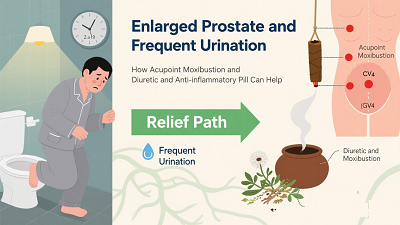Enlarged Prostate and Frequent Urination: How Acupoint Moxibustion and Diuretic and Anti-inflammatory Pill Can Help
Benign prostatic hyperplasia (BPH), also known as an enlarged prostate, is one of the most common health conditions affecting aging men. The prostate sits just below the bladder and surrounds part of the urethra. As it grows larger, it presses against the urethra and interferes with urine flow.
This pressure can trigger a variety of urinary symptoms, collectively called lower urinary tract symptoms (LUTS), which include:
- Needing to urinate more often, especially at night (nocturia)
- Difficulty starting urination
- A weak or interrupted urine stream
- Feeling the bladder hasn’t emptied completely
- Sudden urges to urinate that are hard to control 【Source: NCBI】【Source: Cleveland Urology】

According to the NCBI Bookshelf, although BPH is not cancerous, it can significantly affect quality of life, especially when frequent night urination disrupts sleep【Source: NCBI】.
Why Frequent Urination Happens in BPH
When the prostate enlarges, it narrows the urethral passage. The bladder muscles must work harder to push urine through. Over time, the bladder may become overactive and hypersensitive, leading to frequent urges even when it isn’t full.
If untreated, complications may include recurrent urinary tract infections, bladder stones, kidney damage, or sudden urinary retention (inability to urinate at all)【Source: NCBI】【Source: Cleveland Urology】.
Acupoint Moxibustion: A Traditional Therapy for Relief
Moxibustion is a traditional Chinese therapy that uses the burning of mugwort (Artemisia) to warm specific acupoints on the body. From the TCM perspective, it helps to promote circulation of Qi and blood, disperse stagnation, and restore balance in the lower abdomen.
For men with enlarged prostate and urinary frequency, the gentle heat can:
- Improve blood flow around the prostate and pelvic floor
- Relax tension and relieve discomfort
- Support bladder function and reduce the sensation of incomplete emptying
Step-by-Step Guide to Moxibustion for BPH
Here’s a practical, at-home approach that readers can follow (ideally under professional guidance):
Key Acupoints and Their Benefits
1. Guanyuan (CV4, 3 cun below the navel): Strengthens kidney and bladder function, useful for frequent urination and urgency.
2. Zhongji (CV3, 4 cun below the navel): Regulates bladder Qi, relieves incomplete urination.
3. Qihai (CV6, 1.5 cun below the navel): Boosts lower abdominal energy, alleviates distension.
4. Shenshu (BL23, 1.5 cun lateral to the 2nd lumbar vertebra): Tonifies kidney energy, reduces urinary frequency and lower back soreness.
5. Sanyinjiao (SP6, 3 cun above the medial malleolus): Harmonizes liver, spleen, and kidney; relieves pelvic discomfort.
6. Huiyin (CV1, midpoint between anus and genitals): Acts directly on the prostate, requires extra care to avoid burns.
Techniques
- Mild Moxibustion (Suspended Moxa Stick): Hold the burning moxa stick 2–3 cm from the skin. Warm each acupoint for 10–15 minutes until the area feels comfortably warm and slightly reddish.
- Ginger Moxibustion: Place a thin slice of fresh ginger (0.2–0.3 cm) on the acupoint, pierce small holes in it, then place a burning moxa cone on top. Best for men with “cold-damp” constitutions.
Frequency
- Perform 3–4 times per week.
- A typical course lasts 4–6 weeks.
- If symptoms improve, reduce to 2–3 times weekly to maintain results.
Safety Notes
- Avoid moxibustion during acute infection, fever, or open skin wounds.
- People with poor skin sensation (e.g., diabetic neuropathy) should be cautious.
- Stop immediately if you feel burning or blistering.
Beyond Moxibustion: Lifestyle Adjustments That Make a Difference
Managing urinary symptoms doesn’t rely on one single method. Everyday changes can significantly improve comfort:
1. Fluid Management
- Reduce fluids 2–3 hours before bedtime to minimize night urination.
- Avoid excessive caffeine and alcohol, which irritate the bladder.
2. Bladder Training
- Try “scheduled voiding” every 2–3 hours instead of waiting until urgency.
- Gradually lengthen the time between bathroom visits to train the bladder.
3. Pelvic Floor Exercises
- Kegel exercises strengthen the muscles that control urination.
- Contract pelvic muscles for 5 seconds, relax for 5 seconds; repeat 10–15 times daily.
4. Dietary Adjustments
- Include anti-inflammatory foods such as tomatoes, berries, green tea.
- Reduce spicy, greasy, and high-salt foods that worsen urinary irritation.
5. Maintain Healthy Weight and Activity
- Obesity worsens urinary symptoms.
- Light exercises such as walking or swimming improve circulation and reduce pressure on the bladder.
The Role of Diuretic and Anti-inflammatory Pill
In addition to lifestyle and physical therapies like moxibustion, many men explore herbal formulations for BPH-related urinary symptoms. One notable option is the Diuretic and Anti-inflammatory Pill.
How it works (based on TCM principles):
The formula is designed to clear damp-heat from the lower jiao, promote smooth urination, and improve blood circulation in the prostate region. By addressing both inflammation and urinary obstruction, it helps relieve symptoms such as frequent urination, painful urination, and pelvic discomfort. Over time, these actions support the body in restoring a healthier urinary flow and reducing lingering inflammation that often contributes to chronic prostatitis.
Many patients prefer it as a natural solution that addresses both urinary frequency and the inflammatory process underlying prostate enlargement.
Integrating Treatments: A Balanced Approach
According to the NCBI Bookshelf, conventional management of BPH depends on symptom severity and ranges from “watchful waiting” to medications like alpha-blockers, and in severe cases, surgery【Source: NCBI】.
For men with moderate symptoms who want to avoid or delay invasive treatment, combining:
- Lifestyle adjustments (diet, exercise, fluid control)
- Acupoint moxibustion for circulation and energy balance
- Diuretic and Anti-inflammatory Pill for long-term regulation
- offers a comprehensive, multi-dimensional strategy to regain quality of life.
Frequently Asked Questions (FAQ)
1. Can moxibustion cure an enlarged prostate?
No, it cannot cure the anatomical enlargement. But it can improve circulation and reduce urinary frequency as a supportive therapy.
2. How soon can I expect results from moxibustion?
Most men notice improvement in frequency and urgency after 4–6 weeks of consistent practice.
3. Is Diuretic and Anti-inflammatory Pill safe for long-term use?
It is an herbal formula used in traditional Chinese medicine. However, individual responses vary. Consult a practitioner for guidance, especially if taking other medications.
4. When should I see a doctor urgently?
Seek medical help if you cannot urinate at all, have blood in urine, recurrent infections, or severe kidney/back pain. These may indicate complications of BPH.
References
1. InformedHealth.org (IQWiG, NCBI Bookshelf). Overview: Benign enlarged prostate. Last Update: July 22, 2022.
2. Cleveland Urology. How Does an Enlarged Prostate Affect Urination? 2021–2022.



